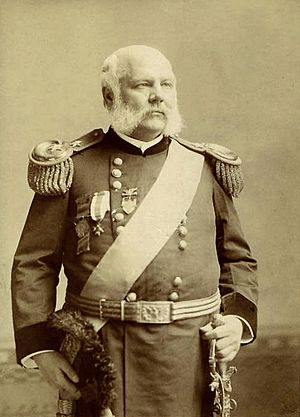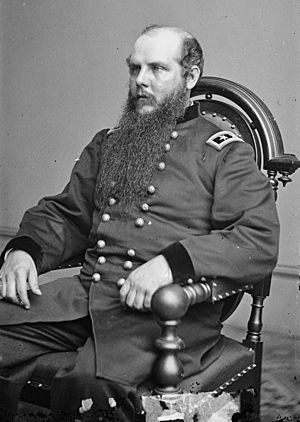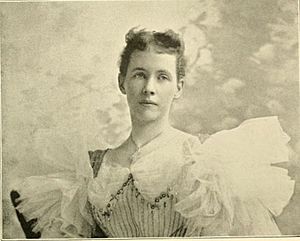John Schofield facts for kids
Quick facts for kids
John Schofield
|
|
|---|---|
 |
|
| Commanding General of the U.S. Army | |
| In office August 14, 1888 – September 29, 1895 |
|
| President | Grover Cleveland Benjamin Harrison Grover Cleveland |
| Preceded by | Philip Sheridan |
| Succeeded by | Nelson A. Miles |
| 28th United States Secretary of War | |
| In office June 1, 1868 – March 13, 1869 |
|
| President | Andrew Johnson Ulysses S. Grant |
| Preceded by | Edwin Stanton |
| Succeeded by | John Aaron Rawlins |
| Personal details | |
| Born |
John McAllister Schofield
September 29, 1831 Gerry, New York, U.S. |
| Died | March 4, 1906 (aged 74) St. Augustine, Florida, U.S. |
| Resting place | Arlington National Cemetery |
| Political party | Republican |
| Education | United States Military Academy (BS) |
| Signature | |
| Military service | |
| Allegiance | • Union |
| Branch/service | United States Army • Union Army |
| Years of service | 1853–1860 1861–1895 |
| Rank | |
| Commands | Superintendent of the United States Military Academy (1876–1881) Army of the Frontier Department of the Missouri XXIII Corps Army of the Ohio |
| Battles/wars | |
| Awards | Medal of Honor |
John McAllister Schofield (September 29, 1831 – March 4, 1906) was an American soldier. He was a major leader during the American Civil War. He later became the U.S. Secretary of War (1868–1869) under President Andrew Johnson. He also served as the top commander of the U.S. Army (1888–1895).
Contents
Early Life and Education
John McAllister Schofield was born on September 29, 1831. His family lived in Gerry, New York. His father was a Baptist minister. The family moved several times, finally settling in Freeport, Illinois.
As a young man, John went to public schools. He helped his family on their farm. He also worked as a land surveyor and a teacher. Later, he was accepted into the United States Military Academy at West Point. He started there on June 1, 1849.
During his last year at West Point, John faced a challenge. He was briefly dismissed from the academy. But he appealed the decision, and it was reversed. He graduated in 1853, ranking seventh in his class. He became a second lieutenant in the artillery.
After graduating, Schofield served in the artillery for two years. He was stationed at Fort Moultrie, South Carolina. He also served in Florida. Later, he returned to West Point as a professor. From 1855 to 1860, he taught natural and experimental philosophy. He then took a break to teach physics at Washington University in St. Louis.
Civil War Service
When the Civil War began, Schofield played an important role. He helped make sure Missouri stayed with the Union. He became a major in the 1st Missouri Infantry Regiment. He served as a chief assistant to Major General Nathaniel Lyon. Lyon was killed during the Battle of Wilson's Creek in August 1861. Schofield showed great bravery in this battle. Years later, he received the Medal of Honor for his actions there.
Schofield was promoted to brigadier general in November 1861. From 1861 to 1863, he led different commands in the western parts of the war. He became a major general in November 1862. At 31, he was one of the youngest major generals in the Civil War.
In 1864, Schofield led the Army of the Ohio. He joined Major General William T. Sherman in the Atlanta Campaign. After Atlanta fell, Sherman marched to the sea. Schofield's army joined Major General George H. Thomas in Tennessee.

Schofield's troops faced Confederate General John Bell Hood. Hood invaded Tennessee. Schofield's command was almost cut off at Spring Hill. Hood then attacked at the Battle of Franklin, which was a major defeat for the Confederates. On December 15–16, Schofield helped Thomas win the Battle of Nashville. This victory greatly weakened Hood's army. For his service at Franklin, Schofield was promoted to brigadier general in the regular army.
Schofield was then ordered to join Sherman in North Carolina. He moved his troops by train and ship. They reached Fort Fisher in 17 days. He took control of Wilmington in February 1865. He fought at Kinston in March. On March 23, he joined Sherman at Goldsboro.
After the War
After the Civil War, President Andrew Johnson sent Schofield to France. His mission was to ask France to remove its troops from Mexico. Schofield also joined the Military Order of the Loyal Legion of the United States. This was a group for Union army officers. He later became its leader.
During the Reconstruction period, President Johnson made Schofield the military governor of Virginia. He was in charge of the First Military District. He oversaw elections where both Black and white citizens voted. These elections led to the Virginia Constitutional Convention of 1868.
When President Johnson asked Edwin M. Stanton to resign, Schofield became the United States Secretary of War. He served in this role from June 1868 to March 1869.
Later Military Career
Schofield was promoted to major general in the regular army on March 4, 1869. This was the same day Ulysses S. Grant became president. Schofield then led the Department of Missouri for a year. This was the Army's second-largest military area.
He later commanded the Military Division of the Pacific. In 1873, he secretly investigated Pearl Harbor in Hawaii. His report suggested that the United States should build a naval port there.
From 1876 to 1881, Schofield was the superintendent of the United States Military Academy at West Point. He worked to reduce hazing and improve professionalism.

In 1880, an African American cadet named Johnson Chesnut Whittaker was found hurt. He said other cadets attacked him. The academy said he made it up. Whittaker was expelled. A government investigation into this event led to Schofield being removed as superintendent in 1881.
Schofield then served in various military divisions across the country. He also visited France to observe military training. He was the first president of the Army and Navy Club.
After General Philip Sheridan died in 1888, Schofield became the top commander of the United States Army. He supported making the military more professional. He also helped improve how officers were promoted. He received the Medal of Honor on July 2, 1892, for his bravery at the Battle of Wilson's Creek in 1861.
On February 5, 1895, he was promoted to lieutenant general. Lieutenant General Schofield retired on September 29, 1895, when he turned 64. Even after retiring, he stayed involved in government. He supported new laws to improve the Army and establish the U.S. National Guard.
Personal Life
John Schofield married Harriet Whitehorn Bartlett. They had two daughters and four sons. Two of their sons died young. Their sons William and Richmond became U.S. Army officers. Harriet died in 1888.
In 1891, at age 60, Schofield married Georgia Wells Kilbourne, who was 27. They had one daughter, Georgiana.
Death and Legacy
John Schofield was the last living member of President Andrew Johnson's cabinet before he died. His book, Forty-six Years in the Army, was published in 1897.
General Schofield died in St. Augustine, Florida on March 4, 1906. He is buried in Arlington National Cemetery. Schofield Barracks, a military base in Hawaii, is named after him.
Today, Schofield is also remembered for a famous quote. All cadets at West Point and other military schools must memorize it. It is about how leaders should treat their soldiers:
The discipline which makes the soldiers of a free country reliable in battle is not to be gained by harsh or tyrannical treatment. On the contrary, such treatment is far more likely to destroy than to make an army. It is possible to impart instruction and give commands in such a manner and such a tone of voice as to inspire in the soldier no feeling, but an intense desire to obey, while the opposite manner and tone of voice cannot fail to excite strong resentment and a desire to disobey. The one mode or other of dealing with subordinates springs from a corresponding spirit in the breast of the commander. He who feels the respect which is due to others cannot fail to inspire in them respect for himself. While he who feels, and hence manifests, disrespect towards others, especially his subordinates, cannot fail to inspire hatred against himself.
– John M. Schofield
Military Ranks
| Insignia | Rank | Date | Component |
|---|---|---|---|
| Brevet Second Lieutenant | July 1, 1853 | 2nd Artillery | |
| Second Lieutenant | August 31, 1853 | 1st Artillery | |
| First Lieutenant | March 3, 1855 | 1st Artillery | |
| Major | April 26, 1861 | 1st Missouri Infantry | |
| Captain | May 14, 1861 | 1st Artillery | |
| Major | June 26, 1861 | 1st Missouri Artillery | |
| Brigadier General | November 21, 1861 | Volunteers | |
| Major General | November 29, 1862 | Volunteers | |
| Brigadier General | March 4, 1863 | Volunteers | |
| Major General | May 12, 1863 | Volunteers | |
| Brigadier General | November 30, 1864 | Regular Army | |
| Brevet Major General | March 13, 1865 | Regular Army | |
| Major General | March 4, 1869 | Regular Army | |
| Lieutenant General | February 5, 1895 | Regular Army |
Images for kids
See also
 In Spanish: John McAllister Schofield para niños
In Spanish: John McAllister Schofield para niños
- List of Medal of Honor recipients
- List of American Civil War Medal of Honor recipients: Q–S
- List of American Civil War generals (Union)



